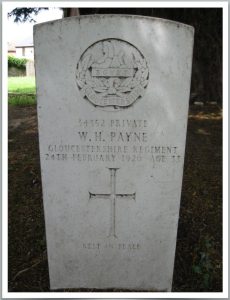3rd (Reserve) Battalion, Gloucestershire Regiment

William Payne’s military service was very short lived: there is a conflict with his family details in the CWGC Register, with evidence from other sources.
William Henry Payne was born in Leonard Stanley in the first half of 1886. According to the Commonwealth War Graves Commission ‘Debt of Honour’ records his parents were Oliver and Harriet Payne, of Leonard Stanley. However it has not proved possible to identify ‘Harriet’ Payne in any BMD or census records.
Oliver Payne married Mary Maria Niblett in 1877 and the latter does conflate with both marriage and census records.
Oliver (1852-1919), was an agricultural labourer and he and Mary Maria (1851-1916) had (according to the 1911 Census) four children, of who two were surviving at that date – these would be Mary Louise (born 1878) and William Henry (1886).
A daughter, Annie Elizabeth lived from 1882-1899 and it has not been possible to identify the remaining child.
From 1891 to at least 1911 the family lived in Leonard Stanley where William’s father Oliver Payne worked as a labourer and other family members in local woollen cloth manufacturing.
On 29 April 1916 William married Ada Hurcombe at Gloucester and they went to live in Marsh Lane, Leonard Stanley. They do not appear to have had any children.
An Army Pension Record has survived for William. It contains his discharge papers from the Army and notes that his trade was a ‘metal work’ and that he lived at March Lane, Leonard Stanley.
He enlisted (more than likely was conscripted) on 23 May 1917 at Gloucester and was posted to the 3rd (Reserve) Battalion of the Gloucestershire Regiment. He was to serve for just 102 days, before being discharged, as ‘no longer physically fit for war service’, on 21 September 1917.
He was discharged with a ‘good conduct’ endorsement ‘during short period of service’.
The reasons for his discharge were set out in a report produced by a medical board at Chatham on 15 August 1917. The 3rd Glosters were, at that time, based in Kent, acting as the Thames-Medway Garrison. The report noted: Disability – chronic asthma (from infancy). Was carried off parade this first afternoon. Has been unable to do much since enlistment: has been in hospital most of the time. Was rejected three times previous to present enlistment.
His condition was seen to have been aggravated by exposure on ordinary military service and so the recommendation was for ‘discharge as permanently unfit’. He was given a disability award of 50% to last until 11 September 1918. His record indicated that there were no grounds for any further award.
According to a recently released Pension Record Card William’s death at age 33 on 24 February 1920 was due to pulmonary tuberculosis. This was obviously linked to the reason for his discharge, as his widow received a pension allowance and he was considered, for CWGC purposes, to be a casualty of the Great War.
He was buried in the churchyard of St Swithun’s, Leonard Stanley, where a standard Commonwealth War Grave Commission headstone marks his grave.
He is commemorated on the Leonard Stanley War Memorial.
Later his widow lived at Ivy House, Wycliffe College, Stonehouse.
Research by Graham Adams 1 June 2021
